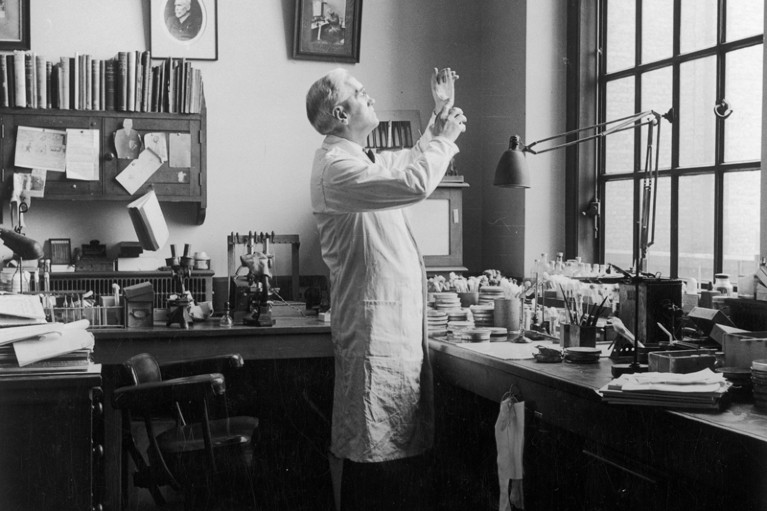
Alexander Fleming’s discovery of penicillin is commonly used as an example of serendipity in science. But how useful is luck really?Credit: Chronicle/Alamy
Science-fiction writer Isaac Asimov is widely credited with saying that “the most exciting phrase to hear in science, the one that heralds new discoveries, is not ‘Eureka!’ but ‘That’s funny’.” Scientific folklore is full of tales of accidental discovery, from the stray Petri dish that led Alexander Fleming to discover penicillin to Wilhelm Röntgen’s chance detection of X-rays while tinkering with a cathode-ray tube.
That knowledge often advances through serendipity is how scientists, sometimes loudly, justify the billions of dollars that taxpayers plough into curiosity-driven research each year. And it is the reason some argue that increasing government efforts to control research — with an eye to driving greater economic or social impact — are at best futile and at worst counterproductive.
But just how important is serendipity to science? Scientists debating with policymakers have long relied on anecdotal evidence. Studies rarely try to quantify how much scientific progress was truly serendipitous, how much that cost or the circumstances in which it emerged.
Serendipity can take on many forms, and its unwieldy web of cause and effect is difficult to constrain. Data are not available to track it in any meaningful way. Instead, academic research has focused on serendipity in science as a philosophical concept.
The European Research Council aims to change that. It has given biochemist-turned-social-scientist Ohid Yaqub a sizeable €1.4-million (US$1.7-million) grant to gather evidence on the role of serendipity in science. Yaqub argues that he has found a way to do so.
First, he defines serendipity in a way that goes beyond happy accidents, by classifying it into four basic types (O. Yaqub Res. Policy 47, 169–179; 2018). The first type is where research in one domain leads to a discovery in another — such as when 1943 investigations into the cause of a mustard-gas explosion led to the idea of using chemotherapy to treat cancer. Another is a completely open hunt that brings about a discovery, such as with Röntgen’s X-rays. Then there are the discoveries made when a sought-for solution is reached by an unexpected path, as with the accidental discovery of how to vulcanize rubber. And some discoveries find a solution to a problem that only later emerges: shatterproof glass for car windscreens was first observed in a dropped laboratory flask.
Starting in the archive of US sociologist Robert K. Merton, Yaqub gathered hundreds of historical examples. After studying these, he says, he has pinned down some of the mechanisms by which serendipity comes about. These include astute observation, errors and “controlled sloppiness” (which lets unexpected events occur while still allowing their source to be traced). He also identifies how the collaborative action of networks of people can generate serendipitous findings.
Yaqub, who works at the University of Sussex in Brighton, UK, is now looking to build a team to use this classification system as a framework for mining the world’s scientific grants. By following the publications and patents that emerge from grants, he hopes to find out how often serendipity arises, and to understand its significance and nature. The hunt will start in biomedicine, but could grow to examine other disciplines.
This seems like a smart way to start attempting something very difficult. And if it proves possible to test the role of serendipity, researchers should do so. Given the paucity of existing evidence, even weak or partial observations could help policymakers to examine the most efficient way to fund research. That could let them balance different modes of funding, for example, or create the environments that encourage serendipity and permit researchers to capitalize on unexpected results.
If happy accidents are just as likely to occur through goal-oriented research as they are through blue-skies research — witness Roy Plunkett’s accidental discovery of non-stick Teflon while looking for non-toxic refrigerants — that could weaken the suggestion that serendipity and research-targeting are necessarily at odds with each other. (The heavy-handed oversight that sometimes goes hand in hand with applied research is a different issue.)
Giving curious minds free rein to explore nature may well be the best way to generate discoveries, but there is no harm in testing that assumption. As taxpayer demands for scrutiny and accountability grow ever louder, just-so stories about Petri dishes and non-stick frying pans, however compelling, no longer make a convincing case.

 Facebook billionaire pours funds into high-risk research
Facebook billionaire pours funds into high-risk research
 Neuroscience: The power of plasma
Neuroscience: The power of plasma
 Drug discovery: A life of tumult and triumph
Drug discovery: A life of tumult and triumph


